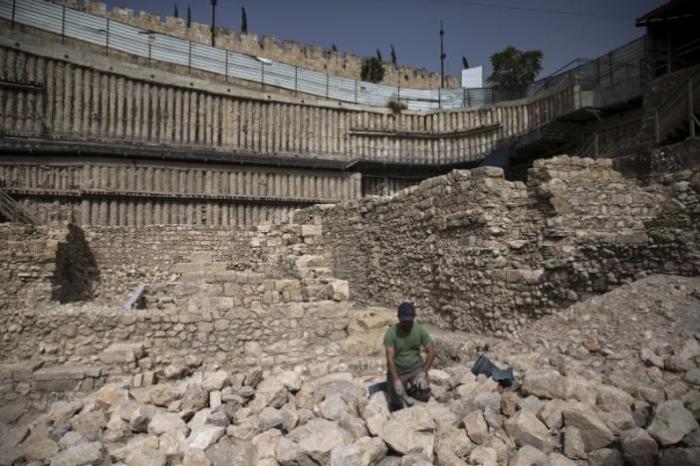
Archaeologists excavating a burial site in Israel’s Negev Desert have uncovered what they say are rare bone and ebony figurines in three early Christian graves. The findings suggest the individuals buried there may have been African converts to Christianity who traveled to the region during the Byzantine era.
Researchers from the Israel Antiquities Authority and the University of Cologne published their findings in the journal Atiqot, reporting that the two ebony figurines, depicting a man and a woman with distinctly African features, could be the first of their kind to be identified in Israel, Jordan or the surrounding region.
The graves, dating to the sixth or seventh century A.D., were discovered at Tel Malhata, an ancient settlement near the Nevatim air base in the northeastern Negev.
“It seems that the figurines depicted ancestors rather than deities. If so, it is possible that the deceased were of ‘Ethiopian’ origin and that they or their ancestors converted to Christianity and moved to the Negev,” the report concludes.
“Ethiopians are known to have lived in many regions of the Greco-Roman world (Snowden 1970:217). Therefore, it is possible that the deceased were of Ethiopian origin and that they moved north to Tel Malḥata.”
Archaeologist Noé D. Michael described the find as unusual for this region, where figurines made from such exotic wood had never been documented before. The blackwood pendants, carved with detailed African-style faces, were unlike anything previously discovered in the Levant.
“As far as we know, no such figurine had ever been identified in Israel, Jordan, and our region,” he told The Times of Israel.
“We believe that since the tombs were close and presented the same kind of burial gifts, they were probably a mother and a child. Unfortunately, we could not extract DNA remains from the bones to run a test.”
The necropolis, or the ancient cemetery, has yielded hundreds of graves from different periods, but this latest discovery stood out for the presence of five figurines — three made of bone and two of ebony — found alongside the remains of two women and a child, according to Smithsonian magazine.
The ebony used was confirmed by experts at Tel Aviv University as Diospyros ebenum, a tree native to southern India and Sri Lanka. The three graves were typical cist tombs — stone-lined burial structures — reflecting Christian burial practices.
One grave held a woman who died between the ages of 20 and 30, buried with two alabaster jars, bronze jewelry and two figurines — one of bone and one of ebony. Another held a child aged 6 to 8, buried with similar grave goods, including another ebony figurine.
The third grave belonged to a young woman aged 18 to 21 and contained glass vessels, a bronze bracelet and a bone figurine of a female figure.
The presence of similar pendants in both the woman’s and the child’s graves led researchers to believe they may have been related. The team said the similarity in style and materials of the ebony figurines suggested a familial link, possibly mother and child.
The study described bone figurines as relatively common in the region, used in domestic rituals and burials since at least the Neolithic period. However, ebony carvings are considered extremely rare.
The researchers noted that the pendants had small holes, indicating they were likely worn around the neck. The team said that although the burials were conducted in the Christian style, the figurines may represent a continuity of older traditions.
The figurines could have been personal items representing ancestral memory and cultural identity, retained even after conversion to Christianity, the researchers noted.
The Tel Malhata site was historically significant as a settlement that existed from the Middle Bronze Age through the Byzantine period.
The town lay at the intersection of two major trade routes — one linking the Red Sea with Judea and Jerusalem, and another connecting the Mediterranean with Arabia and beyond, according to Haaretz. These routes likely facilitated the arrival of luxury goods such as spices, silk and ebony.
Excavations in the 1990s and early 2000s indicated that Tel Malhata was a fortified Roman-period town and later a regional administrative center. The current excavation, conducted near the Nevatim air base, uncovered 155 tombs in total.
The researchers noted that Christian conversion had expanded in the sixth century under Ethiopian Emperor Justin I. They linked the figurines and burial practices to individuals from Ethiopia or the Horn of Africa who may have migrated through established trade and pilgrimage networks.
The team could not extract usable DNA from the skeletal remains, so the geographic origin of the deceased remains speculative. However, they believe the combination of African-style ebony carvings, Christian burial customs and the historical context of trade makes it plausible that the individuals buried at Tel Malhata were early Ethiopian Christian converts.
The archaeologists documented a notable gender pattern in the grave goods across the necropolis. Most women were buried with items such as vessels, jewelry and figurines, while only two men had grave goods, both of whom appeared to be elderly and possibly wealthy.

















